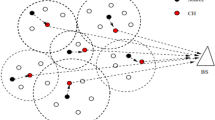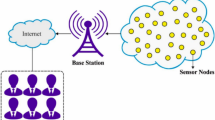Abstract
The growth of Wireless Sensor Networks (WSN) becomes the backbone of all smart IoT applications. Deploying reliable WSNs is particularly significant for critical Internet of Things (IoT) applications, such as health monitoring, industrial and military applications. In such applications, the WSN’s inability to perform its necessary tasks and degrading QoS can have profound consequences and can not be tolerated. Thus, deploying reliable WSNs to achieve better Quality of Service (QoS) support is a relatively new topic gaining more interest. Consequently, deploying a large number of nodes while simultaneously optimizing various measures is regarded as an NP-hard problem. In this paper, a Grey wolf-based optimization technique is used for node deployment that guarantees a given set of QoS metrics, namely maximizing coverage, connectivity and minimizing the overall cost of the network. The aim is to find the optimum number of appropriate positions for sensor nodes deployment under various p-coverage and q-connectivity configurations. The proposed approach offers an efficient wolf representation scheme and formulates a novel multi-objective fitness function. A rigorous simulation and statistical analysis are performed to prove the proposed scheme’s efficiency. Also, a comparative analysis is being carried with existing state-of-the-art algorithms, namely PSO, GA, and Greedy approach, and the efficiency of the proposed method improved by more than 11%, 14%, and 20%, respectively, in selecting appropriate positions with desired coverage and connectivity.














Similar content being viewed by others
References
Salameh, H., Dhainat, M., & Benkhelifa, E. (2019). A survey on wireless sensor network-based IoT designs for gas leakage detection and fire-fighting applications. Jordanian Journal of Computers and Information Technology, 5(2), 60–72.
Zoghi, M., & Kahaei, M. (2012). Sensor management under tracking accuracy and energy constraints in wireless sensor networks. Arabian Journal for Science and Engineering, 37(3), 721–734.
Abidin, H. Z., Din, N. M., Yassin, I., Omar, H., Radzi, N. A. M., & Sadon, S. (2014). Sensor node placement in wireless sensor network using multi-objective territorial predator scent marking algorithm. Arabian Journal for Science and Engineering, 39(8), 6317–6325.
Bouzid, S., Seresstou, Y., Raoof, K., Omri, M., Mbarki, M., & Dridi, C. (2020). Moonga: Multi-objective optimization of wireless network approach based on genetic algorithm. IEEE Access, 8, 105793–105814.
Kumar, D., Aseri, T. C., & Patel, R. (2009). Eehc: Energy efficient heterogeneous clustered scheme for wireless sensor networks. Computer Communications, 32(4), 662–667.
Gupta, S. K., Kuila, P., & Jana, P. K. (2016). Genetic algorithm approach for k-coverage and m-connected node placement in target based wireless sensor networks. Computers & Electrical Engineering, 56, 544–556.
Prasanth, A., & Jayachitra, S. (2020). A novel multi-objective optimization strategy for enhancing quality of service in IoT-enabled WSN applications. Peer-to-Peer Networking and Applications, 13(6), 1905–1920.
Yarinezhad, R., & Hashemi, S. N. (2020). A sensor deployment approach for target coverage problem in wireless sensor networks. Journal of Ambient Intelligence and Humanized Computing, 11,1–16.
Chelbi, S., Dhahri, H., & Bouaziz, R. (2021). Node placement optimization using particle swarm optimization and iterated local search algorithm in wireless sensor networks. International Journal of Communication Systems, 34(9), e4813.
Priyadarshi, R., Gupta, B., & Anurag, A. (2020). Deployment techniques in wireless sensor networks: A survey, classification, challenges, and future research issues. The Journal of Supercomputing, 76, 1–41.
Purushothaman, R., Rajagopalan, S., & Dhandapani, G. (2020). Hybridizing gray wolf optimization (GWO) with grasshopper optimization algorithm (GOA) for text feature selection and clustering. Applied Soft Computing, 96, 10665106651.
Hamidouche, R., Aliouat, Z., Ari, A. A. A., & Gueroui, M. (2019). An efficient clustering strategy avoiding buffer overflow in IoT sensors: A bio-inspired based approach. IEEE Access, 7, 156733–156751.
Mohar, S. S., Goyal, S., & Kaur, R. (2021). Evolutionary algorithms for deployment of sensor nodes in wireless sensor networks: A comprehensive review. In 2nd international conference for emerging technology (INCET) (pp. 1–7). IEEE.
Singh, A., Sharma, S., & Singh, J. (2021). Nature-inspired algorithms for wireless sensor networks: A comprehensive survey. Computer Science Review, 39, 100342.
Deif, D. S., & Gadallah, Y. (2013). Classification of wireless sensor networks deployment techniques. IEEE Communications Surveys & Tutorials, 16(2), 834–855.
Elloumi, S., Hudry, O., Marie, E., Martin, A., Plateau, A., & Rovedakis, S. (2021). Optimization of wireless sensor networks deployment with coverage and connectivity constraints. Annals of Operations Research, 298(1), 183–206.
Harizan, S., & Kuila, P. (2020) Nature-inspired algorithms for k-coverage and m-connectivity problems in wireless sensor networks. In Design frameworks for wireless networks (pp. 281–301). Springer.
Jehan, C., & Punithavathani, D. S. (2017). Potential position node placement approach via oppositional gravitational search for fulfill coverage and connectivity in target based wireless sensor networks. Wireless Networks, 23(6), 1875–1888.
Barkhoda, W., & Sheikhi, H. (2020). Immigrant imperialist competitive algorithm to solve the multi-constraint node placement problem in target-based wireless sensor networks. Ad Hoc Networks, 106, 102183.
Le Nguyen, P., Hanh, N. T., Khuong, N. T., Binh, H. T. T., & Ji, Y. (2019). Node placement for connected target coverage in wireless sensor networks with dynamic sinks. Pervasive and Mobile Computing, 59, 101070.
Harizan, S., & Kuila, P. (2020). A novel NSGA-II for coverage and connectivity aware sensor node scheduling in industrial wireless sensor networks. Digital Signal Processing, 105, 102753.
Balaji, S., Anitha, M., Rekha, D., & Arivudainambi, D. (2020). Energy efficient target coverage for a wireless sensor network. Measurement, 165, 108167.
Liu, Y., Chin, K.-W., Yang, C., & He, T. (2019). Nodes deployment for coverage in rechargeable wireless sensor networks. IEEE Transactions on Vehicular Technology, 68(6), 6064–6073.
Yoon, Y., & Kim, Y.-H. (2013). An efficient genetic algorithm for maximum coverage deployment in wireless sensor networks. IEEE Transactions on Cybernetics, 43(5), 1473–1483.
Binh, H. T. T., Hanh, N. T., Nghia, N. D., Dey, N., et al. (2020). Metaheuristics for maximization of obstacles constrained area coverage in heterogeneous wireless sensor networks. Applied Soft Computing, 86, 105939.
Moh’d Alia, O., & Al-Ajouri, A. (2016). Maximizing wireless sensor network coverage with minimum cost using harmony search algorithm. IEEE Sensors Journal,17(3), 882–896.
Torkestani, J. A. (2013). An adaptive energy-efficient area coverage algorithm for wireless sensor networks. Ad hoc networks, 11(6), 1655–1666.
Vatankhah, A., & Babaie, S. (2018). An optimized bidding-based coverage improvement algorithm for hybrid wireless sensor networks. Computers & Electrical Engineering, 65, 1–17.
Mohar, S. S., Goyal, S., & Kaur, R. (2021). Optimized sensor nodes deployment in wireless sensor network using bat algorithm. Wireless Personal Communications, 116(4), 2835–2853.
Kotiyal, V., Singh, A., Sharma, S., Nagar, J., & Lee, C.-C. (2021). ECS-NL: An enhanced cuckoo search algorithm for node localisation in wireless sensor networks. Sensors, 21(11), 3576.
Al-Aboody, N., & Al-Raweshidy, H. (2016). Grey wolf optimization-based energy-efficient routing protocol for heterogeneous wireless sensor networks. In 4th international symposium on computational and business intelligence (ISCBI) (pp. 101–107). IEEE.
Rajakumar, R., Amudhavel, J., Dhavachelvan, P., & Vengattaraman, T. (2017). GWO-LPWSN: Grey wolf optimization algorithm for node localization problem in wireless sensor networks. Journal of Computer Networks and Communications
Deif, D. S., & Gadallah, Y. (2017). An ant colony optimization approach for the deployment of reliable wireless sensor networks. IEEE Access, 5, 10744–10756.
Mirjalili, S., Mirjalili, S. M., & Lewis, A. (2014). Grey wolf optimizer. Advances in Engineering Software, 69, 46–61.
Kaushik, A., Indu, S., & Gupta, D. (2019). A grey wolf optimization approach for improving the performance of wireless sensor networks. Wireless Personal Communications, 106(3), 1429–1449.
Diop, B., Diongue, D., & Thiare, O. (2014). A weight-based greedy algorithm for target coverage problem in wireless sensor networks. In International conference on computer, communications, and control technology (I4CT) (pp. 120–125). IEEE.
Konak, A., Coit, D. W., & Smith, A. E. (2006). Multi-objective optimization using genetic algorithms: A tutorial. Reliability Engineering & System Safety, 91(9), 992–1007.
Cao, L., Yue, Y., Cai, Y., & Zhang, Y. (2021). A novel coverage optimization strategy for heterogeneous wireless sensor networks based on connectivity and reliability. IEEE Access, 9, 18424–18442.
Author information
Authors and Affiliations
Corresponding author
Ethics declarations
Conflict of interest
On behalf of all authors, the corresponding author states that there is no conflict of interest.
Additional information
Publisher's Note
Springer Nature remains neutral with regard to jurisdictional claims in published maps and institutional affiliations.
Rights and permissions
About this article
Cite this article
Jaiswal, K., Anand, V. A QoS aware optimal node deployment in wireless sensor network using Grey wolf optimization approach for IoT applications. Telecommun Syst 78, 559–576 (2021). https://doi.org/10.1007/s11235-021-00831-9
Accepted:
Published:
Issue Date:
DOI: https://doi.org/10.1007/s11235-021-00831-9




